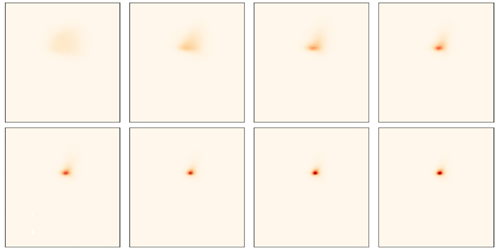A Record Density for Laser-Cooled Molecules
Precision tests of fundamental physics and correlated quantum systems demand direct laser-cooling techniques that can chill a dense collection of molecules to quantum degeneracy. Justin Burau of the University of Colorado Boulder and his colleagues now demonstrate progress toward that goal using a unique magneto-optical trap to compress a cloud of molecules while simultaneously cooling it to sub-Doppler temperatures [1]. Their approach achieves a phase-space density—a measure of how “quantum” a gas is—2 orders of magnitude higher than previous efforts.
Cooling a cloud of molecules to quantum degeneracy requires a multistage process. First, the cloud is confined and laser-cooled to tens of µK in a magneto-optical trap (MOT), where three pairs of counterpropagating laser beams converge at the zero point of a quadrupole magnetic field. Then, the cloud is transferred to a conservative trap (CT), where evaporative cooling is supposed to bring its temperature down to tens of nK. The problem with this approach is that the lasers typically used in molecular MOTs, which are “red detuned” with respect to the molecular resonance, cannot go below the Doppler cooling limit and therefore produce clouds that are relatively warm and diffuse. As a result, the number density of molecules transferred to the CT is usually low.
Burau and his colleagues cool yttrium oxide molecules using a procedure called gray molasses cooling. This technique uses blue-detuned laser light to drive the molecules to a “dark” ground state in which they stop absorbing incident photons. By using light with a certain polarization configuration, together with an MOT’s quadrupole field, they achieve sub-Doppler cooling and generate a position-dependent force that compresses the cloud. The researchers say that this volume compression will help to drastically increase transfer efficiency into CTs from the few-percent levels that are currently possible.
–Rachel Berkowitz
Rachel Berkowitz is a Corresponding Editor for Physics Magazine based in Vancouver, Canada.
References
- J. J. Burau et al., “Blue-detuned magneto-optical trap of molecules,” Phy. Rev. Lett. 130, 193401 (2023).




